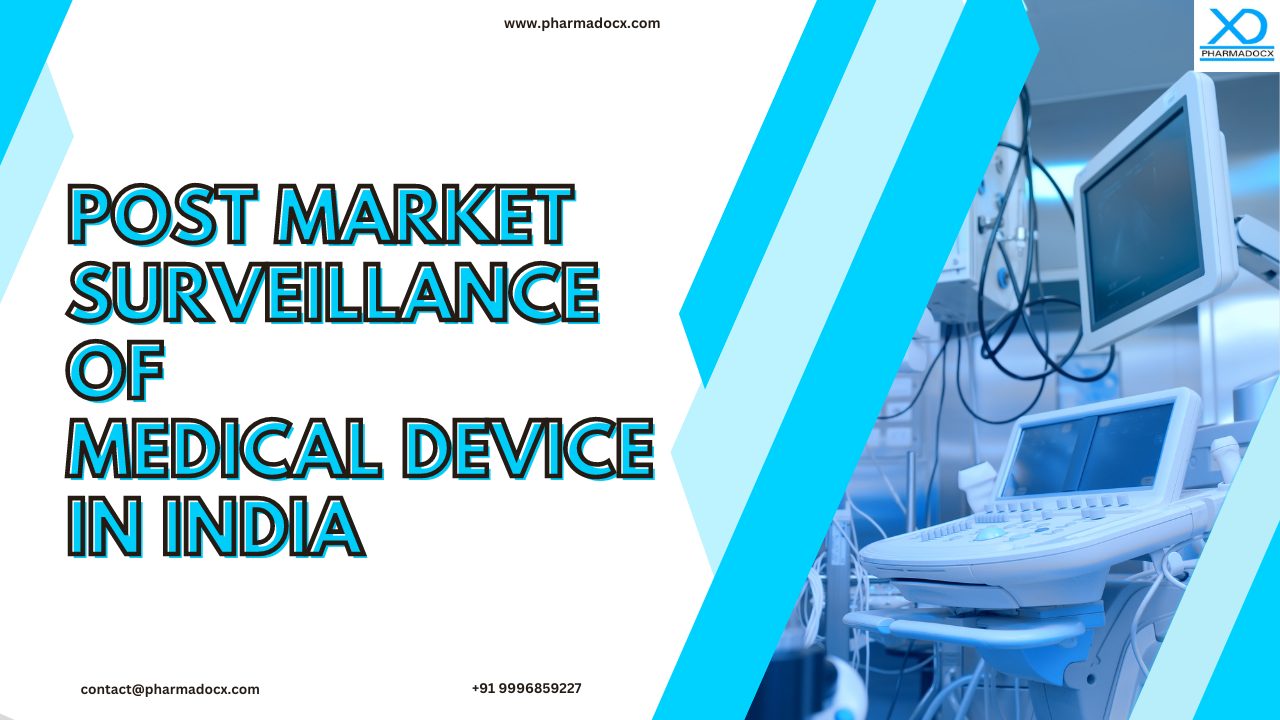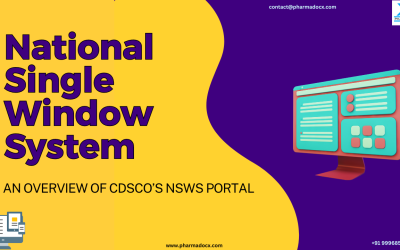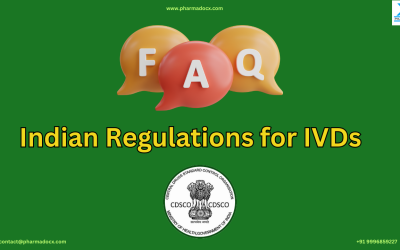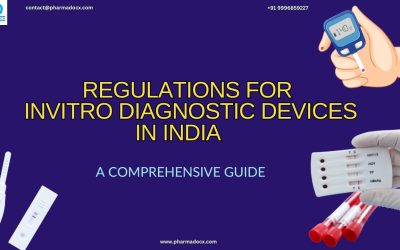Medical devices are essential components of the healthcare system. Hence, strict vigilance of their efficacy and safety is necessary. All safety concerns cannot be identified during the pre-market testing phase. Post market surveillance helps identify any potential flaws warranting corrective action that were not previously detected. Long-term safety concerns that need to be rectified to improve compliance with regulatory policies guidelines are also determined at this stage. India is strengthening its regulatory requirements for post market surveillance of medical devices. In this blog, we will highlight the need for post marketing surveillance of medical device. We will also provide an overview of the current scenario of post market surveillance of medical device in India.
What is post market surveillance for medical devices?
Post market surveillance of medical devices aims to identify problems with the devices that may affect their safety and efficacy. A set of systematic procedures is performed by manufacturers to evaluate the experience of using the medical devices. After the medical devices have entered the market, continuous monitoring of the safety and efficacy of medical devices is performed. The manufacturers collect and analyse data from multiple sources, such as patient feedback, adverse event reports, and device performance data. This will help the manufacturers take any corrective action based on the information collected during post market surveillance. The primary goal is ensuring patient safety by monitoring medical devices while they are in clinical use.
Importance of post market surveillance of medical devices
Clinical trials are used to evaluate medical devices prior to marketing them. However, they have certain limitations, such as small sample size and short duration. Thus, all issues cannot be identified during the pre-market testing phase. Post market surveillance helps determine problems that may arise during long-term use in a diverse patient population. Adverse events or device failures not determined previously can be identified during post market surveillance of medical devices.
Crucial role of healthcare stakeholders in post-market surveillance of medical devices
Post-marketing surveillance is a collaborative process requiring the joint effort of all healthcare stakeholders to improve healthcare quality and outcomes. Training, efficient processes, and infrastructure are required for successful post market surveillance. The following roles played by healthcare stakeholders are a vital component of post marketing surveillance of medical devices:
- Regulators issue guidance and take data-driven measures
- Biomedical/clinical engineers technically investigate the adverse event and incidents
- Healthcare professionals diligently document and report any adverse events
- Hospitals investigate and evaluate failures and share data openly
- Manufacturers perform transparent and vigilant root cause analysis
- A culture of safety and ethics must underly the post market surveillance system
Benefits of post-marketing surveillance of medical devices
The objective is to continuously monitor the medical devices to ensure safety via collaborative effort between manufacturers and regulators. The following highlights the importance and need for post-market surveillance of medical devices:
- Identification of new problems: Post-marketing surveillance helps determine problems, adverse events, and device failures not identified during pre-market trials.
- Identifying recurrent problems: Recurrence of issues can be prevented. Data analysis can highlight recurrent problem. This data can be used to implement corrective measures and prevent similar adverse events.
- Determining underlying causes: Analysing and investigating the problems identified during post-marketing surveillance can help determine the root cause. Whether the problems and failures are due to user errors or device-related can be determined.
- Design Improvements: Post-marketing surveillance data can be used to improve materials and components, redesign products, update software or strengthen cybersecurity.
- Procurement decisions: Unnecessary expenditure on devices with poor safety records can be avoided. Systematically generated information on device safety enables making informed procurement choices.
- Improved safety standards: Post-marketing surveillance real-world data can help improve the safety standards by correcting problematic device features or technology risks found post-marketing.
Post market surveillance of medical device in India
Post marketing surveillance of medical devices is a vital component of the regulatory framework for medical devices in India. Medical Devices Regulations 2017 (MDR) and the Materiovigilance Programme (MvPI) are the two major regulatory guidelines. The regulatory requirements and guidelines apply to all medical devices marketed in India. The requirements for post market surveillance of medical device in India are mentioned in Medical Device Rules (MDR) 2017. The post market surveillance process includes the following: reporting adverse events, recalling unsafe devices, Field Safety Corrective Actions (FSCA), and collecting data from various sources, such as adverse event reports and user complaints. Manufacturers are expected to collect data on the details of the complaints received and corrective and preventive measures taken. India is attempting to tighten and control the post marketing surveillance of medical devices.
Role of the Central Drugs Standard Control Organization in post market surveillance of medical device in India
The Central Drugs Standard Control Organization (CDSCO) regulates all medical devices manufactured and sold in India. It also ensures compliance with post marketing surveillance requirements. The regulatory body oversees the post market surveillance performed by medical device manufacturers. The manufacturers are required to perform post-market surveillance studies and submit post-market surveillance reports for medical devices.
The Materiovigilance Programme of India
The Ministry of Health and Family Welfare, Government of India, launched the Materiovigilance Programme of India (MvPI) in 2015. The goal of this program is to ensure device safety, guide policies and regulations, and promote safe use. This program aims to assure the quality of medical devices sold and used in India. Under this program, vigilance monitoring centres have been established throughout the country. The MvPI has introduced an adverse event reporting form. This form is to be used by manufacturers/importers/distributors, health care professionals, medical practitioners, and other stakeholders. Penalties, fines, and product recalls can be issued in case of failure to comply with the stipulated guidelines and requirements.
Key role of the programme includes:
- Guiding regulatory controls and corrections
- Monitoring adverse events
- Assessing device risks and failures as well as their underlying causes
- Improving quality standards
- Enhancing and monitoring manufacturer vigilance
- Conveying alerts and advisories
Data collected and analyzed during post market surveillance of medical device
During post market surveillance, various types of data are collected and evaluated to identify safety concerns associated with medical devices. The data collected will reveal patient impacts, risks, failure modes, and areas needing action.
- Adverse event reports: Reporting of adverse events is a crucial part of medical device post-market surveillance. These reports present any unexpected or unfavourable side effects that occur while using a medical device. Important safety data is collected from adverse event reports. Manufacturers, healthcare providers, and patients must submit adverse event reports. Patient injuries, product malfunctions, and other safety issues are some examples of adverse events that need to be reported. To identify risks and take corrective actions in order to improve device safety, these reports are analysed.
- Patient feedback: Feedback from patients who have used the medical device is collected. Also, feedback from healthcare experts who have clinical experience with using the medical device is collected.
- Complaints: Information on any complaints or issues related to the device is collected. Data on the support and service provided by the manufacturer are also reviewed.
- Device performance: The medical device’s effectiveness in treating the disease or specific conditions is noted. Information on the device’s durability, dependability, and other performance metrics is a part of device performance data.
- Device registries: Device registries collect predefined technical, clinical, and safety data on real-world use of the medical device. This data is used for long-term monitoring of device safety outcomes and performance.
- Analysis of faulty devices that are returned: Root causes and reasons for failure are determined by analysing faulty devices. This information provides insights into device failure and can be used to improve device safety and efficacy.
- New clinical studies: Additional clinical studies are sometimes performed post-approval. These studies provide further evidence on effectiveness and safety in defined patient groups and settings.
- Academic publications: Research publications on the use, efficacy, and safety of the medical device are evaluated. This helps identify risk factors or safety issues associated with the medical device.
Post-market surveillance of medical devices: A necessity
Post-market surveillance of medical devices plays a critical role in ensuring their safety and efficacy. It acts like an ongoing feedback loop that optimizes medical devices, thereby ensuring the safety of patients. The MvPI fosters a robust guidance for post market surveillance of medical device. It is imperative that manufacturers comply with the requirements of post market surveillance of medical device in India. Pharmadocx Consultants can assist you with all your CDSCO regulatory needs. Call/Whatsapp us at 9996859227 or drop an email at [email protected].





0 Comments